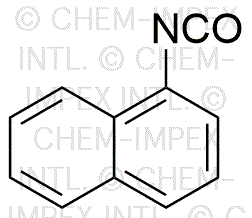1-Naphthyl isocyanate is widely utilized in research focused on:
- Synthesis of Pharmaceuticals: This compound serves as a key intermediate in the synthesis of various pharmaceutical agents, enhancing the efficiency of drug development processes.
- Polymer Chemistry: It is used in the production of polyurethanes, which are essential in creating flexible and durable materials for applications ranging from coatings to foams.
- Analytical Chemistry: This chemical acts as a derivatizing agent for amino acids and amines, improving the detection and analysis of these compounds in complex mixtures.
- Material Science: It plays a role in developing specialty chemicals that improve the performance of materials, particularly in enhancing thermal stability and mechanical properties.
- Agricultural Chemicals: 1-Naphthyl isocyanate is also explored in the formulation of pesticides, contributing to the development of more effective and targeted agricultural solutions.
General Information
Properties
Safety and Regulations
Applications
1-Naphthyl isocyanate is widely utilized in research focused on:
- Synthesis of Pharmaceuticals: This compound serves as a key intermediate in the synthesis of various pharmaceutical agents, enhancing the efficiency of drug development processes.
- Polymer Chemistry: It is used in the production of polyurethanes, which are essential in creating flexible and durable materials for applications ranging from coatings to foams.
- Analytical Chemistry: This chemical acts as a derivatizing agent for amino acids and amines, improving the detection and analysis of these compounds in complex mixtures.
- Material Science: It plays a role in developing specialty chemicals that improve the performance of materials, particularly in enhancing thermal stability and mechanical properties.
- Agricultural Chemicals: 1-Naphthyl isocyanate is also explored in the formulation of pesticides, contributing to the development of more effective and targeted agricultural solutions.
Documents
Safety Data Sheets (SDS)
The SDS provides comprehensive safety information on handling, storage, and disposal of the product.
Product Specification (PS)
The PS provides a comprehensive breakdown of the product’s properties, including chemical composition, physical state, purity, and storage requirements. It also details acceptable quality ranges and the product's intended applications.
Certificates of Analysis (COA)
Search for Certificates of Analysis (COA) by entering the products Lot Number. Lot and Batch Numbers can be found on a product’s label following the words ‘Lot’ or ‘Batch’.
*Catalog Number
*Lot Number
Certificates Of Origin (COO)
This COO confirms the country where the product was manufactured, and also details the materials and components used in it and whether it is derived from natural, synthetic, or other specific sources. This certificate may be required for customs, trade, and regulatory compliance.
*Catalog Number
*Lot Number
Safety Data Sheets (SDS)
The SDS provides comprehensive safety information on handling, storage, and disposal of the product.
DownloadProduct Specification (PS)
The PS provides a comprehensive breakdown of the product’s properties, including chemical composition, physical state, purity, and storage requirements. It also details acceptable quality ranges and the product's intended applications.
DownloadCertificates of Analysis (COA)
Search for Certificates of Analysis (COA) by entering the products Lot Number. Lot and Batch Numbers can be found on a product’s label following the words ‘Lot’ or ‘Batch’.
*Catalog Number
*Lot Number
Certificates Of Origin (COO)
This COO confirms the country where the product was manufactured, and also details the materials and components used in it and whether it is derived from natural, synthetic, or other specific sources. This certificate may be required for customs, trade, and regulatory compliance.


